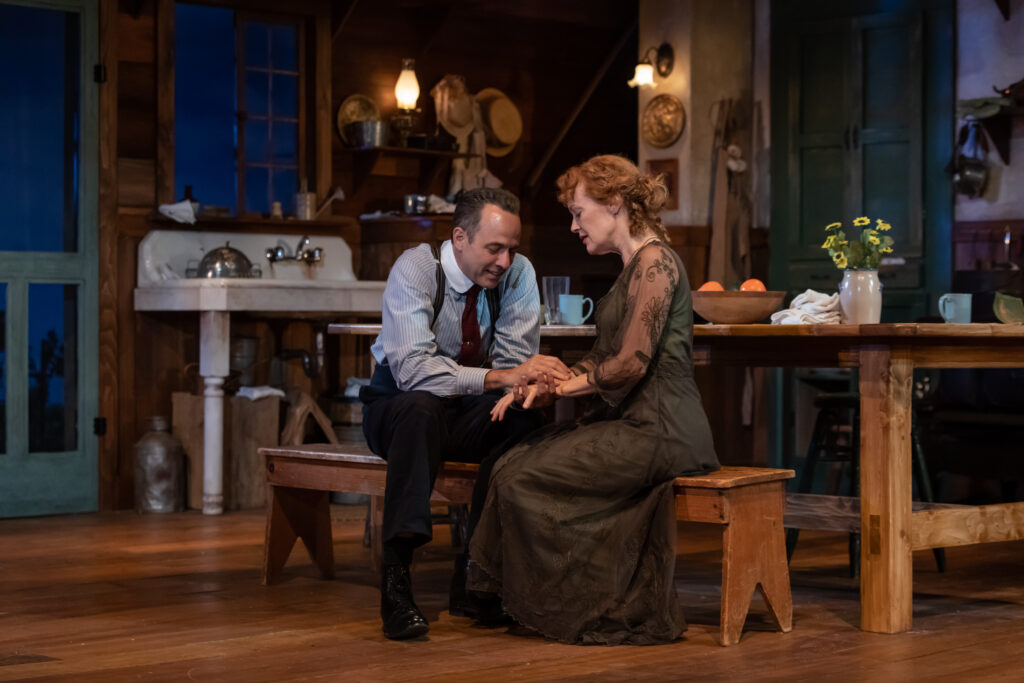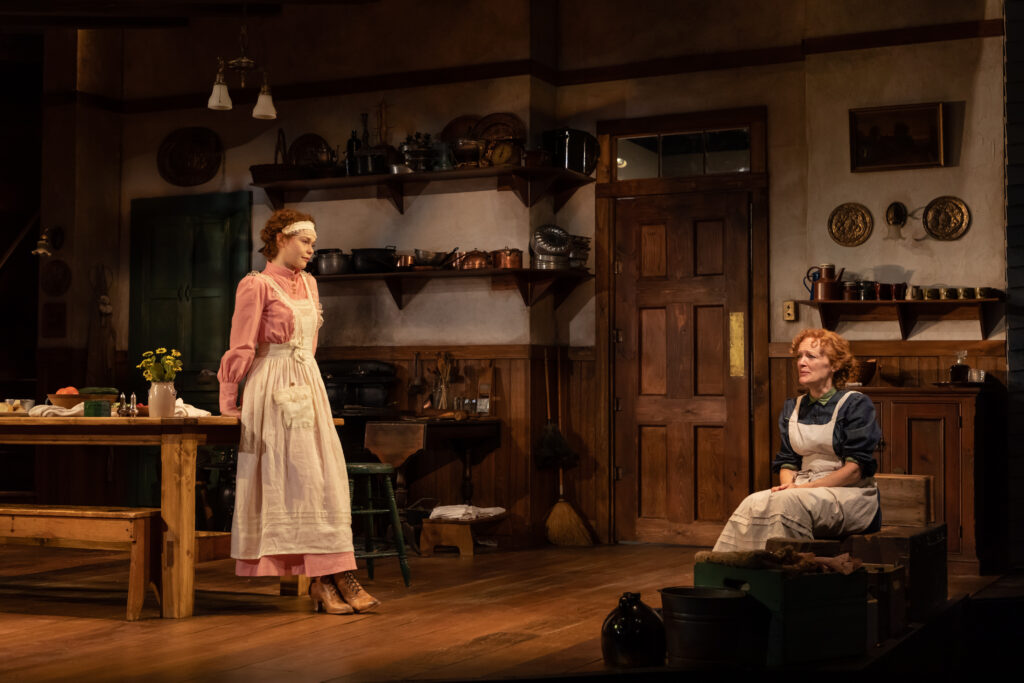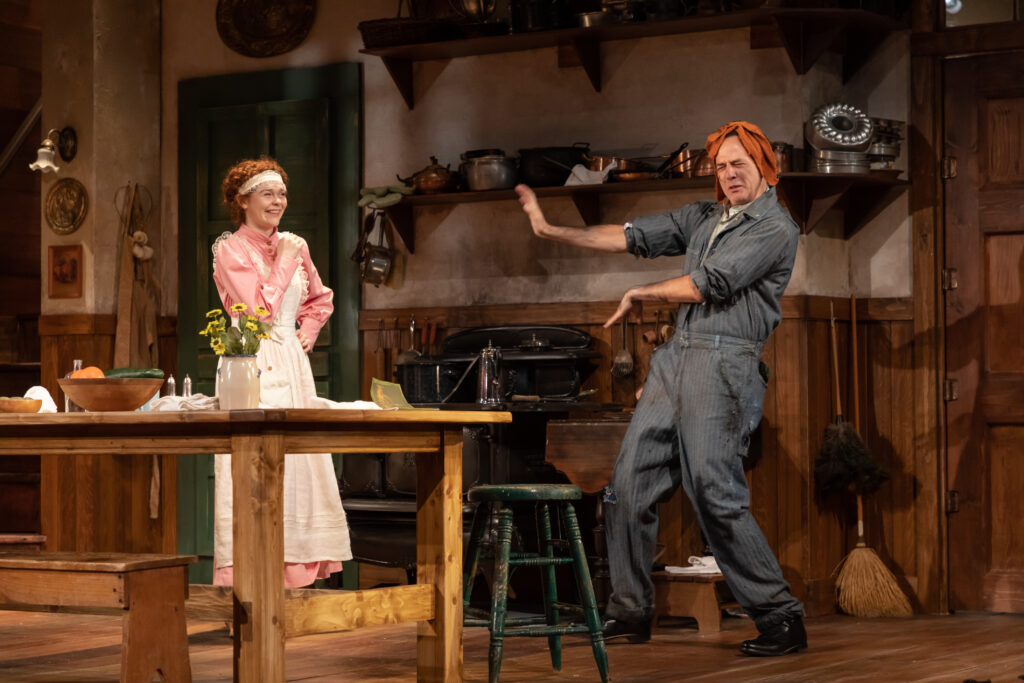
‘Thirst’ — Written by Ronán Noone. Directed by Theresa Rebeck; Scenic Design by Christopher and Justin Swader; Sound Design by Fitz Patton; Lighting Design by Mary Ellen Stebbins, Costume Design by Fabian Fidel Aguilar. Presented by Dorset Theatre Festival, Dorset, Vermont. The run has ended.
by Shelley A. Sackett
Arriving early for “Thirst,” playwright Ronán Noone’s dazzling new play, is a stroke of good ole Irish luck. A crisp sound system pumps toe-tapping traditional pub music, setting a jig-worthy mood. Functional period lamps bathe the livable kitchen set in warmth, creating a cozy tone for arguably the best theatrical experience of the 2022 summer season.
By the time the Irish lilted announcements herald the play’s start, the audience has been transported to another time and another place.
And what a time and place it is.
Noone sets “Thirst” in the kitchen of the Tyrone family’s seaside Connecticut home on the August day in 1912 when Eugene O’Neill’s classic tragedy, “A Long Day’s Journey Into Night” takes place. [Although familiarity with that play is not a prerequisite to “getting” ‘Thirst,’ Noone sprinkles his script with delicious breadcrumbs for those who have tasted the original to follow.]
While the Tyrones spend the day destroying themselves and each other offstage in their toile-wallpapered dining room, their cook, kitchen maid and chauffer spend theirs in the kitchen, sitting around the table together, enjoying their privacy and relative freedom while performing their demeaning menial duties. Their individual posts may have led them to this quasi-family-by-default situation, but they are genuine in their interactions. They bicker, they laugh, they tease and they worry. But they do it together, and it comes from their hearts. They genuinely need and enjoy each other’s company.
Each brings a different, but similar, back story to the mix.
Bridget Conroy emigrated from Ireland 16 years ago to become the Tyrone’s cook. Her outer shell is brittle and cynical, but she saves her harshest criticism and reproach for herself, especially for her closeted alcoholism. Yet, the only time she emerges from her carapace is when she’s juiced enough to black out the shame and regrets that poison her every sober breath and thought. Only then can she express — and admit to — the love and need she has for Jack.

For his part, Jack Smythe, a local native and the Tyrone’s chauffeur, grew up poor in this place that is playground to the spoiled rich. He yearns to leave his hometown with its paper trail witnessing his past transgressions and finally, as he approaches middle age, set out to secure his independence and happiness.
Last, but hardly least, is the winsome new arrival, Cathleen Mullen, Bridget’s 18-year-old niece who miraculously survived her trip over on the ill-fated Titanic. She is feisty and blindly optimistic, determined to climb the golden ladder of American success.
These three flawed characters bring real troubles and equally real compassion to their shared table. Bridget was banished from her home after giving birth at age 16; that birth is only thing she has done in her life that she’s proud of, in spite of its personal cost. Like the penitent sinner she believes herself to be, she dutifully sends money and a letter to her family every week. In 16 years, she has received not even a postcard in return. Although she loved the beach in Ireland, she won’t go to the sea just down the street, either because it makes her too homesick or because she must deny herself all pleasure as penance for her sin, or — most likely — both.
Jack was a drunk, so far gone he couldn’t face his wife’s illness and death and even missed her funeral, when Bridget found him in the street and, like a sick stray, took him home and nursed him back to physical and spiritual health. In return, Jack is determined to offer her the same life raft and save her from a life of self-pity and recrimination — a life he knows too well — not because he owes her, but because he loves her.
Cathleen’s bubble is burst when, shortly after arriving in America, she receives a letter from her fiancé announcing he is ditching her for a woman with property. She’s more annoyed and humiliated than heartbroken. Young, ambitious and resilient, she naively throws herself behind a ditzy plan to become the next “it” girl on Broadway.
These three have more in common than their woes, regrets and heartbreaks. They are survivors and they share a determination to live, no matter the consequences. They also really care about each other. Noone, with his well-tuned ear and light touch, pens robust yet sleek dialogue that tackles a lot of big ticket topics (shame, redemption, assimilation, discrimination to name a few) while staying grounded in the here and now of these three individuals and their intertwined daily lives.

Rebeck’s direction is economical, efficient and effective, and she lets each actor spread their wings and breathe life and individuality into their characters. They inhale, they exhale, they react, interact and bring each other lightness and laughter. Kathy McCafferty, as Bridget, is a whirling dervish of anger and productivity, and the kitchen is her made-to-order stage. She cooks (making real scrambled eggs over a real range), scrubs, arranges, rearranges and throws pots and pans, all while letting fly mouthfuls of rapid-fire heavily accented lines.
David Mason brings a lanky self confidence and Kevin Costner-esque genuineness to his Jack. He is a regular, decent guy who made a mistake, acknowledges it and just wants a shot at the brass ring with the girl of his dreams — nothing more, but nothing less.
Rounding out the trio is the lithesome and impossibly creamy-skinned (think yogurt, not heavy cream) Meg Hennessy as the vivacious Cathleen. She brings comic timing, physicality and a gift for facial mood changes that are as talented as they are entertaining.
If there is a flaw, it is that the women’s accented rapid-fire delivery is often muffled or lost, a shame (and annoyance) considering the richness of Noone’s craftmanship. A little microphone could go a long way.
That aside, there are too many positives to give them all justice. Mary Ellen Stebbins’ lighting paints the day’s passing with a sun shape shifting across the kitchen walls. Fitz Patton makes optimum use of a terrific sound system. And Christopher and Justin Swader’s set design, with its punctuating swinging back door, adds more than a mere scenic element — it is an escape route from all the Tyrone kitchen represents to a world of fresh air and fresh starts.
That door swings both ways. Jack and Bridget, after two plus hours, finally manage to cross over the threshold to the land of hope and promise. And Cathleen? Only time — and perhaps a sequel — will tell.

